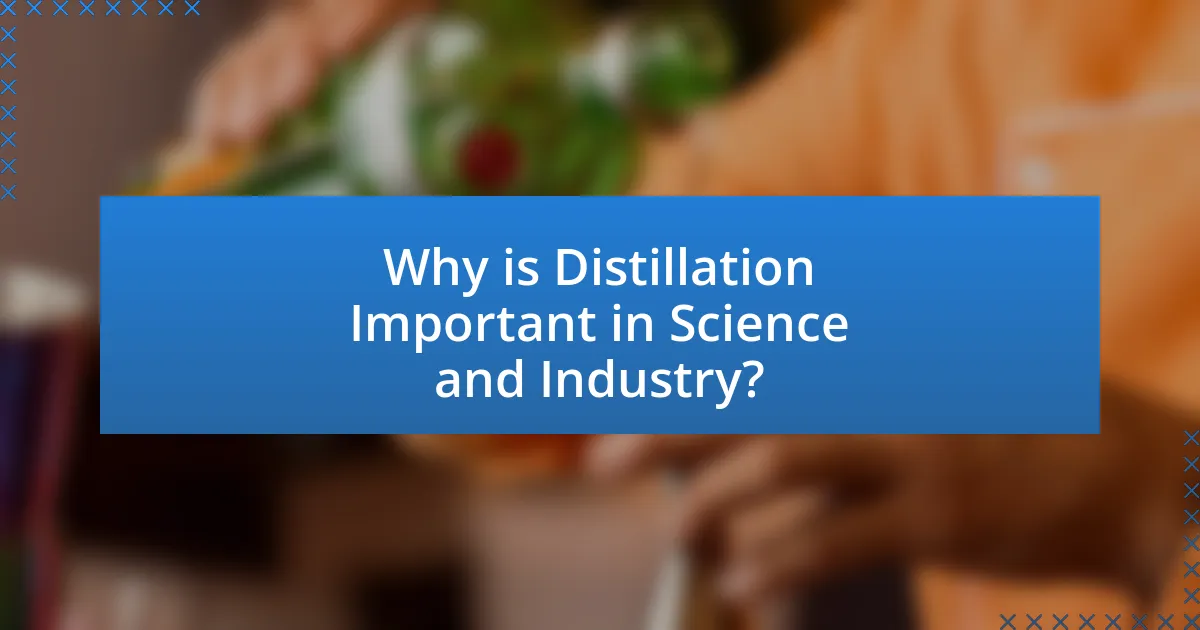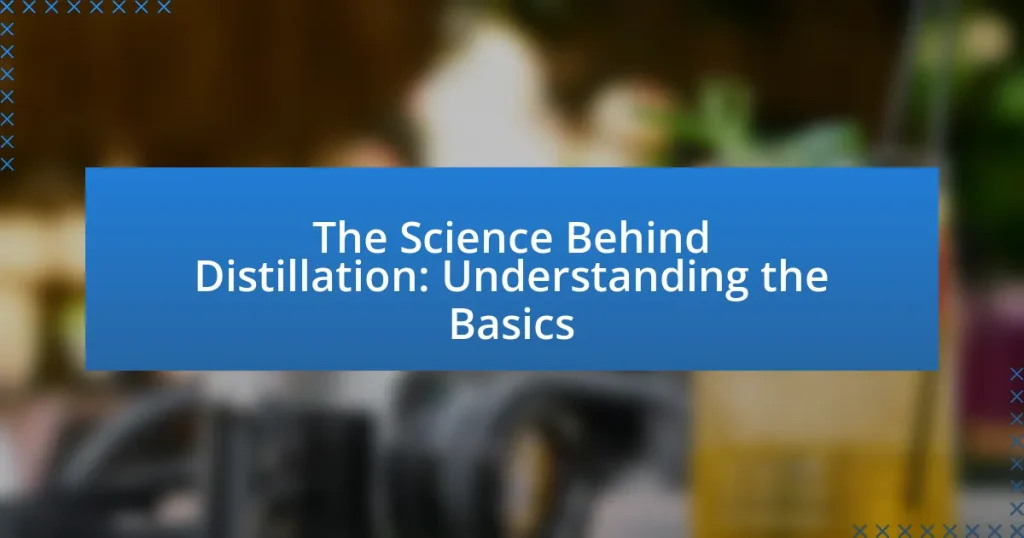Distillation is a fundamental separation process that involves heating a liquid to create vapor and then cooling the vapor to obtain a liquid, effectively purifying substances based on their boiling points. The article explores the mechanics of distillation, including its key components, the influence of temperature and pressure, and various methods such as simple, fractional, steam, and vacuum distillation. It highlights the importance of distillation in industries like petrochemicals and alcohol production, detailing its applications, benefits, and challenges. Additionally, the article addresses best practices for optimizing distillation processes and troubleshooting common issues to ensure high purity and efficiency in chemical separations.

What is Distillation?
Distillation is a separation process that involves heating a liquid to create vapor and then cooling the vapor to obtain a liquid. This technique is commonly used to purify liquids or separate components based on differences in boiling points. For example, in the production of alcoholic beverages, distillation separates ethanol from water and other components, allowing for higher alcohol concentrations. The effectiveness of distillation is supported by its widespread application in industries such as petrochemicals, where it is used to refine crude oil into various fuels and chemicals.
How does the process of distillation work?
Distillation is a separation process that involves heating a liquid to create vapor and then cooling the vapor to obtain a liquid. This method exploits differences in boiling points of components in a mixture, allowing for the effective separation of substances. For example, in the distillation of ethanol from a fermentation mixture, ethanol boils at 78.37°C, while water boils at 100°C. By heating the mixture, ethanol vaporizes first, and upon cooling, it condenses back into a liquid, thus separating it from water and other components. This principle is widely used in industries such as alcohol production and petroleum refining, demonstrating its practical applications and effectiveness in separating mixtures based on boiling point differences.
What are the key components involved in distillation?
The key components involved in distillation are the distillation apparatus, the heat source, the vapor, and the condenser. The distillation apparatus typically includes a boiling flask, a distillation column, and a receiving flask. The heat source is used to vaporize the liquid mixture, allowing the more volatile components to transition into vapor. The vapor then travels through the distillation column, where it may undergo further separation based on boiling points. Finally, the condenser cools the vapor, converting it back into liquid form, which is collected in the receiving flask. This process relies on the principle that different substances have distinct boiling points, enabling their separation.
How do temperature and pressure influence distillation?
Temperature and pressure significantly influence the efficiency and effectiveness of distillation. Higher temperatures increase the vaporization rate of the liquid, allowing components with lower boiling points to evaporate more readily. Conversely, lower pressures lower the boiling points of liquids, enabling distillation to occur at reduced temperatures, which can prevent thermal degradation of sensitive compounds. For instance, vacuum distillation utilizes reduced pressure to distill substances at lower temperatures, preserving their integrity while separating them based on boiling points. This relationship between temperature, pressure, and boiling point is fundamental in distillation processes, as evidenced by the principles outlined in Raoult’s Law, which describes how vapor pressure varies with temperature and composition in mixtures.
What are the different types of distillation methods?
The different types of distillation methods include simple distillation, fractional distillation, steam distillation, vacuum distillation, and azeotropic distillation. Simple distillation is used for separating liquids with significantly different boiling points, while fractional distillation is effective for separating mixtures with closer boiling points by using a fractionating column. Steam distillation is utilized for temperature-sensitive compounds, allowing for the extraction of essential oils without decomposition. Vacuum distillation lowers the boiling points of liquids by reducing pressure, making it suitable for high-boiling substances. Azeotropic distillation is employed to separate azeotropes, which are mixtures that exhibit constant boiling behavior. Each method serves specific applications based on the properties of the substances being distilled.
What is simple distillation and when is it used?
Simple distillation is a separation technique used to purify liquids by heating them to create vapor and then cooling the vapor to collect the liquid. This method is commonly employed when separating a liquid from non-volatile impurities or when the boiling points of the components differ significantly, typically by at least 25 degrees Celsius. For example, simple distillation is effectively used in the purification of water from salt or in the production of distilled spirits, where ethanol is separated from water and other components.
How does fractional distillation differ from simple distillation?
Fractional distillation differs from simple distillation primarily in its ability to separate mixtures of liquids with closer boiling points. Simple distillation is effective for separating components with significantly different boiling points, typically greater than 25 degrees Celsius apart, while fractional distillation employs a fractionating column that allows for multiple vaporization-condensation cycles, enhancing the separation of components with smaller boiling point differences. This method is particularly useful in industries such as petrochemical refining, where complex mixtures require precise separation, demonstrating its efficiency in achieving higher purity levels compared to simple distillation.
What is steam distillation and its applications?
Steam distillation is a separation process that utilizes steam to extract volatile compounds from a mixture, primarily used for isolating essential oils from plant materials. This method operates by passing steam through the plant material, which causes the essential oils to evaporate; the steam and vaporized oils are then condensed back into liquid form, allowing for the collection of the essential oils. Applications of steam distillation include the production of essential oils for aromatherapy, flavoring in the food industry, and extraction of fragrances in cosmetics. The technique is favored for its ability to separate heat-sensitive compounds without degradation, making it a preferred method in the essential oil industry.

Why is Distillation Important in Science and Industry?
Distillation is important in science and industry because it is a fundamental separation technique used to purify liquids and separate components based on differences in boiling points. This process is essential in various applications, including the production of alcoholic beverages, petrochemical refining, and the purification of solvents and chemicals. For instance, in the petroleum industry, distillation is used to separate crude oil into valuable fractions like gasoline, diesel, and kerosene, which are critical for energy production and transportation. Additionally, distillation plays a vital role in laboratory settings for isolating compounds and ensuring the purity of chemical substances, thereby supporting research and development across multiple scientific fields.
What are the primary applications of distillation?
The primary applications of distillation include the separation of liquid mixtures, purification of chemicals, and production of alcoholic beverages. Distillation is widely used in industries such as petrochemical, pharmaceutical, and food processing to isolate components based on differences in boiling points. For instance, in the petrochemical industry, crude oil is distilled to produce gasoline, diesel, and other valuable products, demonstrating its critical role in resource extraction and refinement.
How is distillation used in the production of alcoholic beverages?
Distillation is used in the production of alcoholic beverages to separate alcohol from the fermentation mixture based on differences in boiling points. During distillation, the fermented liquid is heated, causing the alcohol to vaporize, while other components remain in liquid form. The vapor is then collected and cooled, condensing it back into liquid alcohol, which is typically higher in alcohol content than the original mixture. This process is essential for producing spirits like whiskey, vodka, and rum, where the desired alcohol concentration is significantly higher than that found in beer or wine. Distillation not only increases the alcohol content but also influences the flavor profile of the final product by allowing for the selective capture of volatile compounds.
What role does distillation play in the petrochemical industry?
Distillation is a critical process in the petrochemical industry, primarily used for separating and purifying various hydrocarbon components from crude oil. This separation occurs based on differences in boiling points, allowing for the extraction of valuable products such as gasoline, diesel, and other petrochemicals. The efficiency of distillation is evidenced by its widespread application in refineries, where it accounts for a significant portion of the processing steps, often involving multiple distillation columns to achieve the desired purity and yield of products.
What are the benefits of using distillation?
The benefits of using distillation include the ability to separate and purify liquids based on differences in boiling points. This process is essential in industries such as petrochemicals, where it is used to refine crude oil into gasoline and other products. Distillation also allows for the concentration of alcoholic beverages, ensuring higher purity and flavor. Additionally, it is employed in water purification, effectively removing contaminants and producing safe drinking water. The efficiency of distillation is evidenced by its widespread application, with the global distillation equipment market projected to reach approximately $5.5 billion by 2026, highlighting its critical role in various sectors.
How does distillation ensure purity in chemical processes?
Distillation ensures purity in chemical processes by separating components based on differences in boiling points. During distillation, a mixture is heated to vaporize the more volatile components, which then condense back into liquid form in a separate container, effectively isolating them from less volatile impurities. This method is widely used in industries such as petrochemicals and pharmaceuticals, where high purity levels are essential; for example, the distillation of crude oil yields various purified products like gasoline and diesel. The efficiency of distillation in achieving high purity is supported by its ability to repeatedly cycle the vaporization and condensation process, enhancing separation and reducing contamination.
What economic advantages does distillation provide?
Distillation provides significant economic advantages by enabling the efficient separation and purification of valuable components from mixtures. This process allows industries, such as petrochemicals and pharmaceuticals, to maximize yield and reduce waste, leading to lower production costs. For instance, in the petroleum industry, distillation is used to separate crude oil into various fractions, which can be sold at higher prices than the unrefined product. Additionally, distillation requires less energy compared to other separation methods, further enhancing cost-effectiveness. According to the U.S. Department of Energy, optimizing distillation processes can lead to energy savings of up to 30%, demonstrating its economic viability.

What Challenges are Associated with Distillation?
Distillation faces several challenges, including energy consumption, separation efficiency, and equipment costs. Energy consumption is significant, as distillation requires heating and cooling processes that can be energy-intensive, leading to high operational costs. Separation efficiency can be affected by factors such as the volatility of components and azeotropes, which complicate the separation of mixtures. Additionally, the initial investment in distillation equipment can be substantial, particularly for large-scale operations, which may deter smaller enterprises from utilizing this method. These challenges highlight the complexities involved in the distillation process and its economic implications.
What are common issues encountered during distillation?
Common issues encountered during distillation include temperature control, equipment leaks, and contamination of the distillate. Temperature control is crucial because improper temperatures can lead to incomplete separation of components, resulting in lower purity. Equipment leaks can cause loss of product and affect the efficiency of the process, while contamination can occur from residual substances in the apparatus, leading to compromised quality of the final product. These issues are well-documented in chemical engineering literature, emphasizing the importance of maintaining optimal conditions and equipment integrity for successful distillation.
How can temperature control affect distillation outcomes?
Temperature control directly influences distillation outcomes by determining the volatility of components in a mixture. Precise temperature regulation allows for the selective vaporization of specific compounds, enhancing separation efficiency. For instance, maintaining a consistent temperature gradient can optimize the separation of ethanol from water, as ethanol has a lower boiling point (78.37°C) compared to water (100°C). This controlled environment minimizes the risk of thermal degradation of sensitive compounds, ensuring higher purity and yield in the final distillate.
What are the risks of contamination in distillation processes?
The risks of contamination in distillation processes include the introduction of impurities from feed materials, equipment, and the environment. Impurities can originate from raw materials that contain unwanted substances, such as residual solvents or microbial contaminants. Equipment contamination can occur if distillation apparatus is not properly cleaned, leading to cross-contamination between batches. Environmental factors, such as airborne particles or chemical vapors, can also contribute to contamination during the distillation process. These risks can compromise the purity of the final product, affecting its quality and safety for consumption or use.
How can distillation processes be optimized?
Distillation processes can be optimized by improving energy efficiency, enhancing separation effectiveness, and utilizing advanced control technologies. Energy efficiency can be increased by implementing heat integration techniques, such as using heat exchangers to recover and reuse heat within the system, which can reduce overall energy consumption by up to 30%. Enhancing separation effectiveness involves optimizing column design and operating conditions, such as adjusting reflux ratios and feed compositions, which can lead to higher purity levels and yield. Advanced control technologies, including model predictive control and real-time monitoring systems, enable precise adjustments to operating parameters, resulting in improved process stability and reduced downtime. These strategies collectively contribute to more efficient and cost-effective distillation operations.
What techniques can improve the efficiency of distillation?
Techniques that can improve the efficiency of distillation include the use of fractional distillation, increased surface area in distillation columns, and the application of vacuum distillation. Fractional distillation enhances separation by utilizing multiple theoretical plates, allowing for better separation of components with close boiling points. Increasing surface area in distillation columns, achieved through packing materials or structured trays, promotes more effective vapor-liquid contact, leading to improved mass transfer. Vacuum distillation lowers the boiling points of substances, reducing energy consumption and minimizing thermal degradation of heat-sensitive materials. These techniques are supported by empirical studies demonstrating enhanced separation efficiency and reduced operational costs in industrial applications.
How can one troubleshoot common distillation problems?
To troubleshoot common distillation problems, one should first identify the specific issue, such as poor separation, low yield, or unexpected temperature readings. For instance, if poor separation occurs, it may indicate insufficient reflux ratio or column packing issues, which can be resolved by adjusting the reflux ratio or ensuring proper packing material is used. If low yield is observed, it could be due to inadequate heat input or improper feed composition, necessitating adjustments in heating or feed quality. Unexpected temperature readings may suggest a malfunctioning thermometer or incorrect placement, requiring verification of equipment calibration and positioning. Each of these troubleshooting steps is grounded in the principles of distillation, where factors like temperature, pressure, and composition directly influence the efficiency and effectiveness of the process.
What are best practices for successful distillation?
Best practices for successful distillation include maintaining optimal temperature control, ensuring proper equipment cleanliness, and selecting suitable materials for distillation. Temperature control is crucial as it affects the separation of components; for instance, maintaining a steady boiling point allows for efficient vaporization and condensation. Clean equipment prevents contamination, which can alter the purity of the distillate. Additionally, using high-quality raw materials ensures that the initial product has the desired characteristics, leading to a more effective distillation process. These practices are supported by industry standards and research, which emphasize the importance of precision and quality in achieving successful distillation outcomes.


